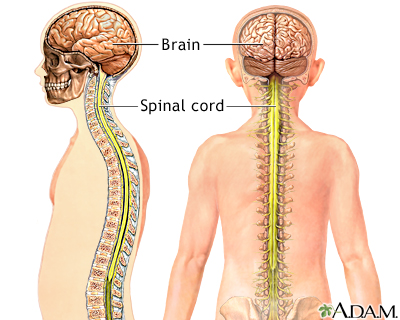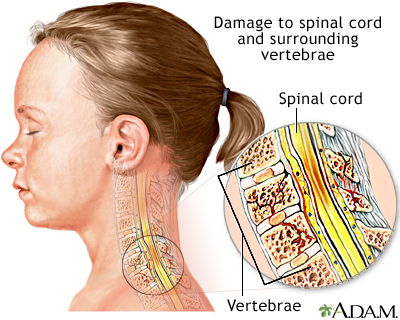Health Library
Spinal injury
Spinal cord injury; SCI
The spinal cord contains the nerves that carry messages between your brain and the rest of the body. The cord passes through your neck and back. A spinal cord injury is very serious because it can cause loss of movement (paralysis), function, and sensation below the site of the injury.
Images








Presentation

I Would Like to Learn About:
Causes
A spinal cord injury may be caused by incidents such as:
- Bullet or stab wound
- Fracture of the spine
- Traumatic injury to the face, neck, head, chest, or back (for example, a car accident)
- Diving accident
- Electric shock
- Extreme twisting of the middle of the body
- Sports injury
- Falls
Symptoms
Symptoms of a spinal cord injury may include any of the following:
- Head that is in an unusual position
- Numbness or tingling that spreads down an arm or leg
- Weakness
- Difficulty walking
- Paralysis (loss of movement) of arms or legs
- Loss of bladder or bowel control
- Shock (pale, clammy skin, bluish lips and fingernails, acting dazed or semiconscious)
- Lack of alertness (unconsciousness)
- Stiff neck, headache, or neck pain
First Aid
Never move anyone who you think may have a spinal injury unless it is absolutely necessary. For example, if you need to get the person out of a burning car or help them to breathe.
Keep the person completely still and safe until medical help arrives.
- Call the local emergency number, such as 911.
- Hold the person's head and neck in the position in which they were found. DO NOT try to straighten the neck. DO NOT allow the neck to bend or twist.
- DO NOT allow the person to get up and walk.
If the person is not alert or responding to you:
- Check the person's breathing and circulation.
- If needed, do CPR. DO NOT do rescue breathing or change the position of the neck, do chest compressions only.
DO NOT roll the person over unless the person is vomiting or choking on blood, or you need to check for breathing.
If you need to roll the person over:
- Have someone help you.
- One person should be located at the person's head, the other at the person's side.
- Keep the person's head, neck, and back in line while you roll them onto one side.
Do Not
- DO NOT bend, twist, or lift the person's head or body.
- DO NOT attempt to move the person before medical help arrives unless it is absolutely necessary.
- DO NOT remove a football helmet or pads if a spinal injury is suspected.
When to Contact a Medical Professional
Call your local emergency number (such as 911) if you think someone has a spinal cord injury. Do not move the person unless there is urgent danger.
Prevention
The following may lower your risk for spinal injury:
- Wear seat belts.
- Do not drink and drive.
- Do not dive into pools, lakes, rivers, and other bodies of water, particularly if you cannot determine the depth of the water or if the water is not clear.
- Do not tackle or dive into a person with your head.
Related Information
Spinal cord traumaReferences
American Red Cross. First Aid/CPR/AED Participant's Manual. Dallas, TX: American Red Cross; 2016. cdn1.thprd.org/pdfs2/document4085.pdf.
Kaji AH, Hockberger RS. Spinal injuries. In: Walls RM, Hockberger RS, Gausche-Hill M, eds. Rosen's Emergency Medicine: Concepts and Clinical Practice. 9th ed. Philadelphia, PA: Elsevier; 2018:chap 36.
BACK TO TOPReview Date: 6/13/2021
Reviewed By: C. Benjamin Ma, MD, Professor, Chief, Sports Medicine and Shoulder Service, UCSF Department of Orthopaedic Surgery, San Francisco, CA. Also reviewed by David Zieve, MD, MHA, Medical Director, Brenda Conaway, Editorial Director, and the A.D.A.M. Editorial team.
 | A.D.A.M., Inc. is accredited by URAC, for Health Content Provider (www.urac.org). URAC's accreditation program is an independent audit to verify that A.D.A.M. follows rigorous standards of quality and accountability. A.D.A.M. is among the first to achieve this important distinction for online health information and services. Learn more about A.D.A.M.'s editorial policy, editorial process and privacy policy. A.D.A.M. is also a founding member of Hi-Ethics. This site complies with the HONcode standard for trustworthy health information: verify here. |
The information provided herein should not be used during any medical emergency or for the diagnosis or treatment of any medical condition. A licensed medical professional should be consulted for diagnosis and treatment of any and all medical conditions. Links to other sites are provided for information only -- they do not constitute endorsements of those other sites. © 1997- 2021 A.D.A.M., a business unit of Ebix, Inc. Any duplication or distribution of the information contained herein is strictly prohibited.
